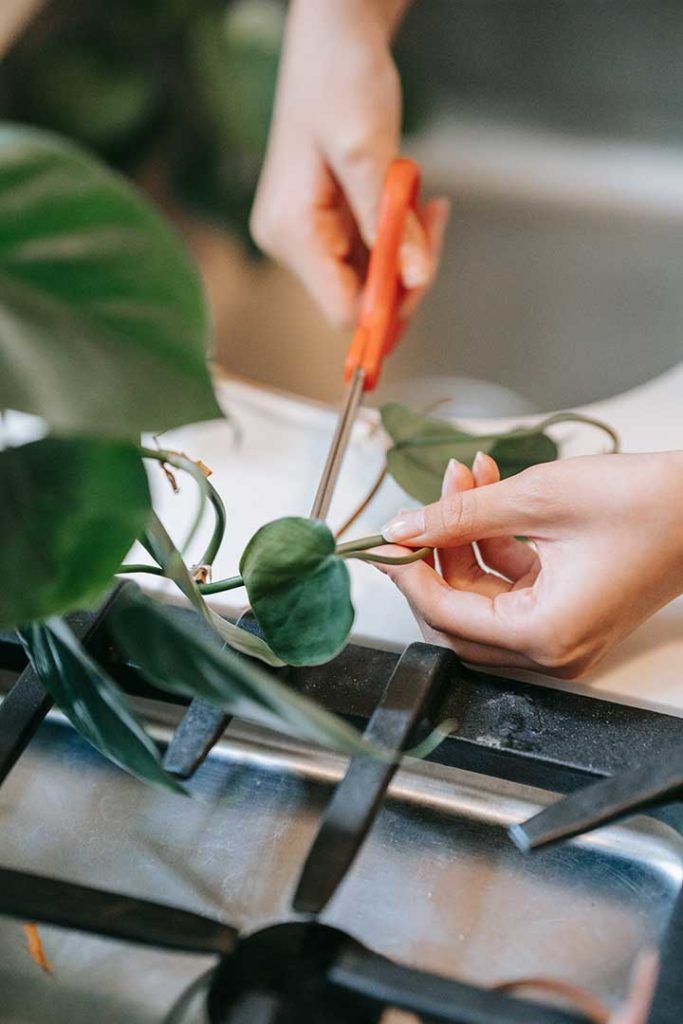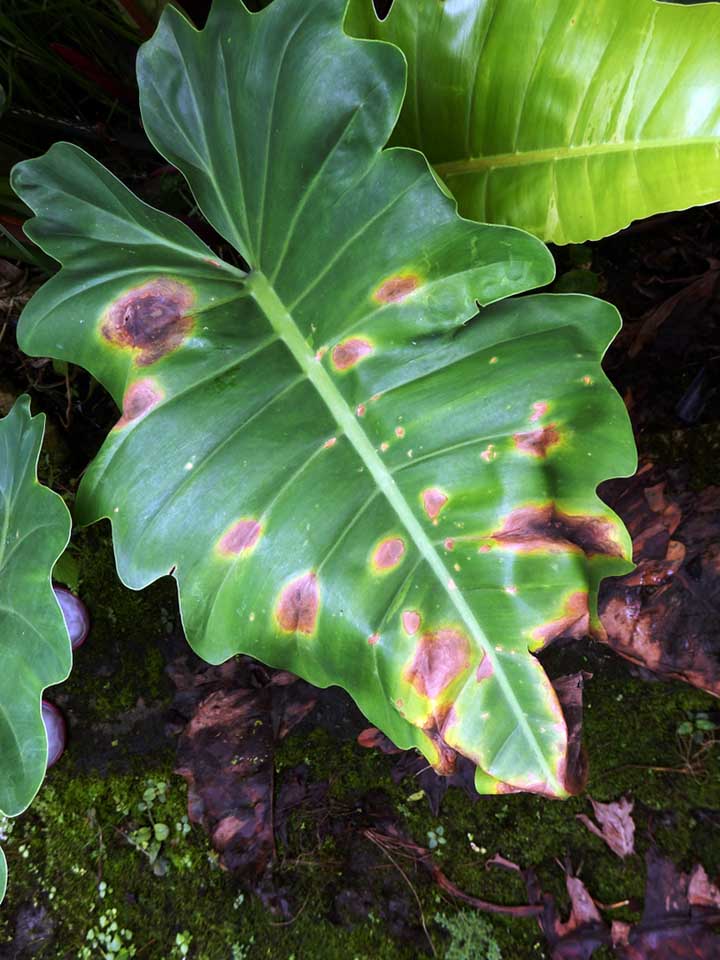Philodendrons are popular plants whether grown indoors or outside, depending on your climate. Unfortunately, as with any plant, philodendrons have some disease problems. You may wonder, “Why Does My Philodendron Have Brown, Yellow, Black, White… Spots?”
It is always distressing when a plant you love gets spots or other signs of diseases. This care guide discusses the causes of the spots and what to do to treat them.
Why Does My Philodendron Have Brown, Yellow, Black, White… Spots?
Bacterial and fungal leaf spots cause different color spots at different stages of the disease. Bacterial leaf spot is wet, with water-soaked spots. The fungal leaf spot is dry. Both can kill your plant if left untreated. Cold injuries can also cause leaf spots.
Table of Contents
What Causes the Different Color Leaf Spots on My Philodendron Leaves?
Different diseases and pests cause different symptoms. Among those symptoms are different colored spots. These spots may change color as the problem progresses. If you find spots on your philodendron, check the possible causes below. Then read more about those problems in the next section.
Black
Bacterial leaf spot leaves black spots on the leaves when the disease is advanced.
Brown
Advanced bacterial leaf spot causes large, irregular, brown spots on leaves.
Yellow
Fungal leaf spot causes yellow or yellowish-green spots at first.
White
Watering with cold water can cause white spots on the leaves where the water hits them.
Dark Green
Cold injury can cause dark green spots between the veins of the leaves.
Translucent
Bacterial leaf spot causes translucent spots on leaves that appear water-soaked.
What Cause Spots on Philodendrons?
These are the most common causes of spots on philodendrons.
Bacterial Leaf Spot
Most bacterial leaf spot first causes translucent, water-soaked spots on the leaves between the veins. The spots have a yellow halo around them. The center of the spots may rot and fall off the leaf, leaving a hole behind. As they get larger, spots turn brown, then black. The leaf will have a rotten smell at this point.
Fungal Leaf Spot
Fungal leaf spot causes many tan to reddish-brown spots on the leaf. These spots can enlarge and merge. In addition, these spots often have tiny black spots within them. If the fungus attacks new leaves near the top of the plant, it can kill the plant.
Cold Injury
Cold injury can cause dark green or white spots on the leaves, whether from cold air or cold water.
How Do You Distinguish Fungal Leaf Spot from Bacterial Leaf Spot?
Bacterial leaf spots are water-soaked and may ooze, while fungal leaf spots are dry.
Do We Need Different Treatments for Difference Spots Color?
For the most part, bacterial leaf spots and fungal leaf spots are treated the same. However, with fungal leaf spots, some chemicals help. Cold injuries have some of the same remedies as bacterial or fungal leaf spots but also some differences.
How Do You Treat Leaf Spots on Philodendron?
For all three causes of leaf spots:
- Remove the leaves that have spots on them.
- Reduce the humidity around the plant.
- Make sure the philodendron has space around it so the air can circulate around the leaves.
- Finally, do not get water on the leaves when watering.
If a fungal leaf spot is causing leaves to drop, you can use a fungicide formulated for indoor use, such as Bonide 775 Copper Fungicide. Using a fungicide is not usually necessary, however, if you take the above steps.
For cold injury, in addition to the steps above, place the plant in a warmer place and make sure the plant is not subject to cold drafts. Use warm, but not hot, water instead of cold water when watering the philodendron.
If the plant is outside and cannot be brought in before temperatures get below 55 degrees, use a frost cloth to cover the plant and protect it from the cold.
How Do You Prevent Spots on Philodendrons?

Most bacterial and fungal leaf spot diseases are in the soil. They spread when the soil splashes on a leaf, usually during watering.
For this reason, do not get water on the leaves when watering your philodendron. Make sure the plant has space around it so the air can circulate and dry the leaves.
Keep the potting soil evenly moist but do not let it get soggy. Water in the morning, so any water that gets on the leaves dries quickly.
If your plant is outdoors, using drip irrigation or a soaker hose to water it will help protect it from both bacterial and fungal leaf spots.
A layer of three inches of mulch around the plant will keep the soil from being splashed on the leaves.
If one of your plants gets sick, isolate it from other plants, so the disease doesn’t spread.
Always clean your pots and saucers before reusing them. First, wash them in soap and water, then sterilize them in bleach water for 30 minutes.
Sterilize your tools like pruning shears and scissors between plants, too. Doing this will keep you from spreading diseases between your plants.
Plants that die after getting leaf spots should be put in the trash, not the compost pile. You do not want leaf spot diseases to spread to your compost pile.
Some Common Types of Philodendrons that Usually Have Problems with Spots
All types of philodendrons can get spots. However, the ones listed below are more likely to have this problem.
- Philodendron birkin
- Philodendron micans
- Philodendron rojo congo
- Philodendron xanadu
- Heart leaf philodendron (Philodendron hederaceum var. oxycardium)
- Philodendron pink princess (Philodendron erubescens’ Pink Princess’)
- Philodendron selloum
- Philodendron brazil
- Lemon lime philodendron (Philodendron hederaceum ‘Lemon Lime’)
- Moonlight philodendron (Philodendron ‘Moonlight’)
Frequently Asked Questions
Will My Monstera Deliciosa get spots on it?
The Monstera deliciosa is sometimes called the split-leaf philodendron. While there are split-leaf philodendrons, these are entirely different plants from the Monstera deliciosa. The Monstera deliciosa is related to the philodendron but is not a philodendron. Therefore, while it may get spots, some causes may differ.
One of my other houseplants has spots. Will they spread to my philodendron?
They may. Anytime you have a sick plant, you should isolate it so that whatever makes it sick doesn’t spread to your other plants.
All the leaves of my philodendron have gotten black and stink. Can my plant be saved?
No, you should discard the plant in the trash. Do not reuse the pot and saucer the philodendron was in until you wash it well with soap and water and sterilize it in bleach water for 30 minutes.
In conclusion, the two most common causes of spots are bacterial leaf spots and fungal leaf spots.
Bacterial leaf spot causes wet, water-soaked spots. Fungal leaf spot causes dry spots.
The treatment for both is similar. Cold injury can also cause leaf spots. Follow the treatment for other leaf spots and keep the plant warmer—water with warm water, not cold water.
Chemical treatment of leaf spots is usually not necessary.
